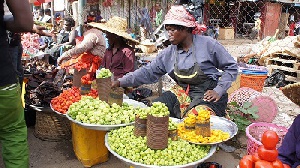Prices of some commodities in the Tamale metropolis and Sagnarigu municipality of the Northern Region continue to soar following price increases of fuel, transportation, farm input devices and other factors.
The prices have not been stable since beginning of the year, and been a headache for traders, residents, government and private workers who have not seen any increment in salaries and other remunerations and therefore had to strive to make earns meet.
Some traders and residents have also been expressing worry over the price hikes for goods and services, school fees, utility tariffs as well as accommodation, which has put pressure on the families to always seek assistance in order to meet family needs.
They noted that failure of policymakers to address the issues might not augur well for the country to meet any of the Sustainable Development Goals (SDGs) by 2023.
While some were of the view that during political season goods and services decline, they expressed worry at the rate at which utility tariffs, fuel and other economic factors continue increasing without word from government to explain what is happening.
Market survey data obtained by the Business and Financial Times (B&FT) from the market and some shopping malls in the metropolis and municipality indicated that prices of major food items such as maize, soya bean, cowpeas and vegetables continue to increase.
In Tamale, most of the traders and consumers rely on the vegetables from Burkina Faso sold from trucks at Choggu market.
A bowl of Jasmine local rice which used to be GH¢15 now goes for GH¢30.00; Nasia from GH¢30 to GH¢40;, ginger from GH¢20 to GH¢30 per bowl; maize from GH¢15 to GH¢30; a crate of eggs from GH¢18 to GH¢30, depending on the size; Frytol oil 4.5L was GH¢65 but is now GH¢110.00; Ideal milk 30ml was GH¢4.50 but now GH¢6; brown sugar 1kg was GH¢12 and is now GH¢20; Royal Aroma Rice 5kg was GH¢45 but is now GH¢95 while Lele is GH¢95-150; and Voltic Cool Pac medium goes for GH¢32 and big size GH¢34.
Some vegetables have seen an increase in price – including an olonka of tomatoes which used to be GH¢30 but now goes for GH¢50; pepper from GH¢45 is now sold at GH¢60; and three fingers of carrot has gone from GH¢6 to GH¢12 among others.
Also, some food commodities like maize, rice and yam have recorded some increase in prices, with maize recording an increase from GH¢120 to GH¢450 for the white and GH¢450 for the yellow; a bag of rice increased from GH¢30 per 5kg to GH¢90-150 per 5kg depending on the brand; and three tubers of yam went from GH¢10 to GH¢20.
Tamale is strategically located in the Northern Region, and with this strategic location the metropolis and municipality have market potential for local goods from the agricultural and commerce sectors from other districts in the region.
Some of these food commodities are from Burkina Faso, Togo, Cote d’Ivoire and Benin, among others.
Some hospitality operators have expressed worry, saying their investment always go back to the market due to the continuous increments in market prices.
Ellen Amoakoh of Ellen Ventures – a provisions shop – also expressed worry about the price increments of commodities resulting in low patronage.
“When we make low sales, it affects our businesses because we have to look for money to pay the utility and rent bills,” she added.
Executive Director-Del Cusine, Stanley Cowther, said the continuous hikes in prices are affecting the industry and businesses, and therefore called on government to aid the plight of local businesses in the region.
The Northern Regional Agricultural officer for Statistics and Research, Alhassan Abdul-Fatau, in an interview with the B&FT said the regional office is making efforts for the farmers to cultivate enough crops to feed the populace.
“With the current market prices, we cannot so anything because it is a national issue; but what the office can do is supervise farmers to increase production and harvest enough to feed the nation,” he said.
Business News of Tuesday, 4 June 2024
Source: thebftonline.com

















